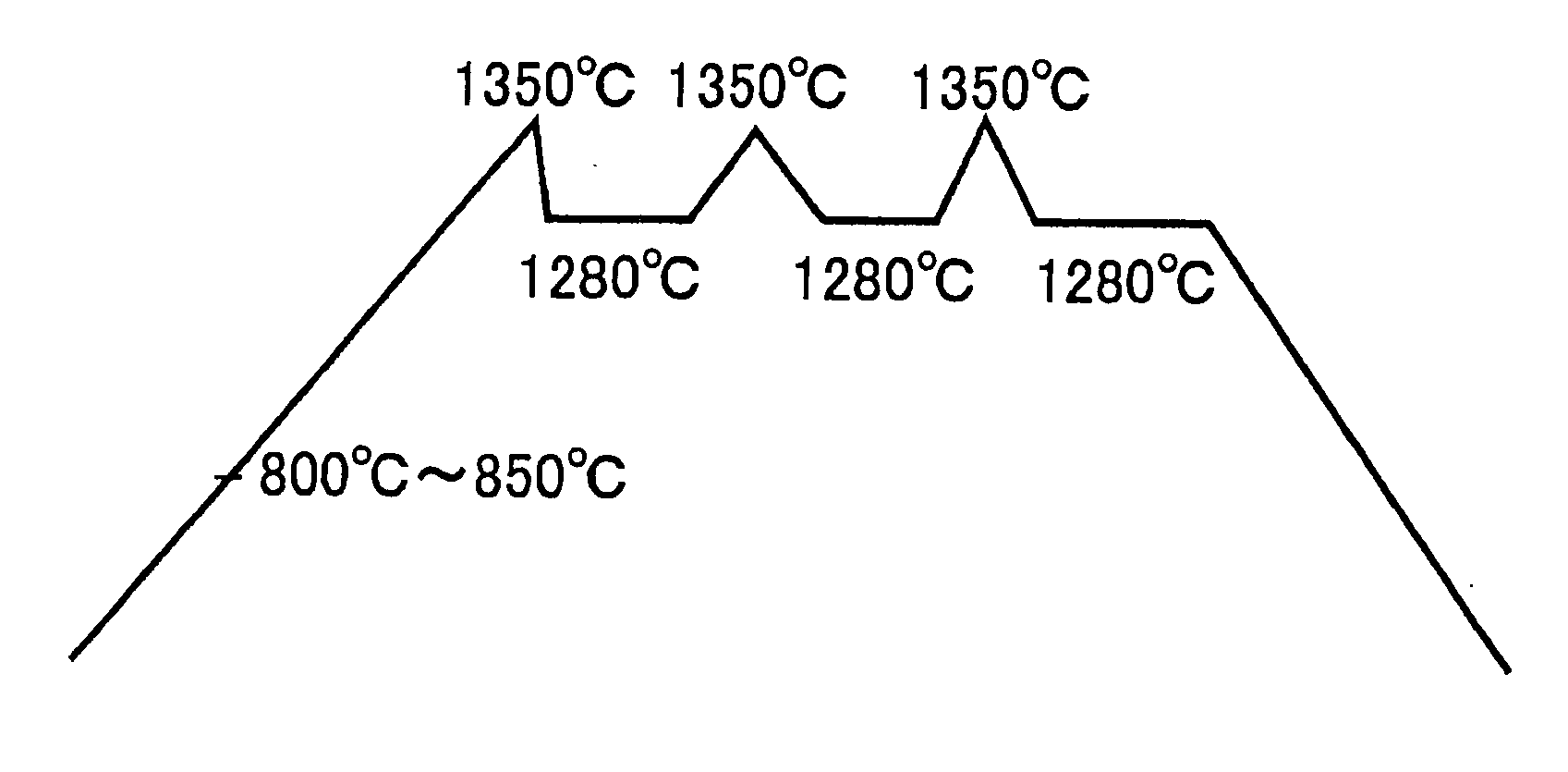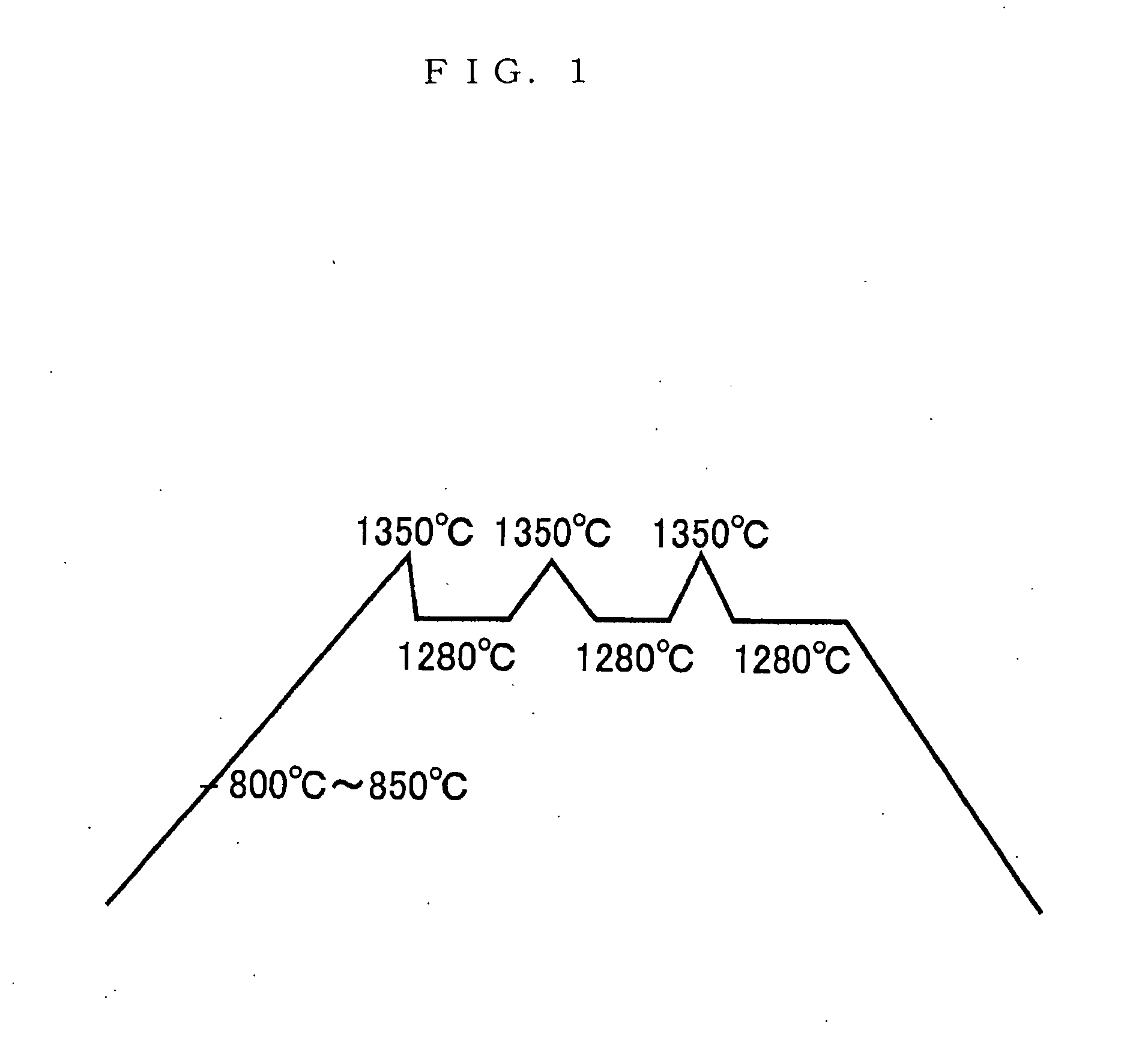Catalyst oxide for changing quality of fossil fuel
- Summary
- Abstract
- Description
- Claims
- Application Information
AI Technical Summary
Benefits of technology
Problems solved by technology
Method used
Image
Examples
embodiment 1
[0050] Clay oxide:8.8 weight % is mixed with CeO2: 35.7 weight %, ThO2: 20 weight %, ZrO2: 20 weight %, SnO2O: 0.3 weight %, CuO2: 0.2 weight %, CoO: 0.7 weight %, and MgO2: 15 weight % to crush them to grain size 250 mesh.
[0051] Water is added to the mixture, blended and molded, which is placed in a reduction calcinations state at 800 to 850° C. in a reduction furnace, and a temperature is raised to 1350° C. to effect sintering. The calcinations conditions are that as shown in FIG. 1, there are taken four hours to raise a temperature to 1350° C., 30 minutes to lower a temperature down to 1280° C., and maintained three hours in a state of 1280° C.; a temperature is raised to 1350° C. for 30 minutes, and a temperature is lowered to 1280° C. for 30 minutes to maintain it for three hours; and a temperature is raised to 1350° C. for 30 minutes, and a temperature is lowered to 1280° C. for 30 minutes to effect sintering for four hours.
[0052] The thus obtained ceramics catalyst can be u...
embodiment 2
[0053] Clay oxide:15.7 weight % is mixed with Ce: 27 weight %, Co: 7 weight %, Th: 20 weight %, Zr: 18 weight %, Mg: 4 weight %, Sn: 1.2 weight %, Pd: 4.8 weight %, Ni:0.9 weight %. and Mo:1.4 weight % to crush them to 250 mesh.
[0054] Water is added to the mixture, blended and molded, which is placed in a reduction calcinations state at 800° C. in a reduction furnace, and a temperature is raised to 1450° C. to effect sintering. The calcinations conditions are that as shown in FIG. 2, there are taken three hours to raise a temperature to 1450° C., maintained one hour at a temperature of 1450° C., maintained four hours lowering a temperature from 1450° C. to 1320° C. for 30 minutes, one hour raising a temperature to 1450° C. to for 30 minutes, four hours lowering a temperature to 1320° C. for 30 minutes, one hour raising a temperature to 1450° C. to for 30 minutes, and lowering a temperature to 1320° C. for 30 minutes to effect sintering for four hours.
[0055] The thus produced catal...
embodiment 3
[0057] The catalyst oxide of ceramics 1 produced according to the above-described embodiment is made to be spherical (8 to 10 mm), on which is coated a platinum·rhenium catalyst within 2 mm 2, about 20 weight % of the total weight of which is added to obtain a catalyst oxide of ceramics, which was filled into a stainless steel container 5 connected to a piping between a light oil fuel tank 3 and an engine 4 of Diesel engine vehicle·KC-WGE4T and KC-WGEAT (2t vehicle) of Matuda as shown in FIG. 3. The black smoke quantity, NOx quantity (g / kwh), CO quantity (g / kwh), HC quantity (g / kwh), and PM quantity (g / kwh) were tested by Foundational juridical person: Nihon Automobile Transport Technical Association. The results are as given in Table 1 below.
TABLE 1Discharge gas componentsCOHCNOxPMTest results of Akishima Laboratory5.7811.4204.5580.694National reference values(2-t vehicle)9.2003.8007.8000.960Measured values prior to mounting10.3725.6629.0161.311
[0058] Discharge gases of a Diesel ...
PUM
| Property | Measurement | Unit |
|---|---|---|
| Temperature | aaaaa | aaaaa |
| Temperature | aaaaa | aaaaa |
| Temperature | aaaaa | aaaaa |
Abstract
Description
Claims
Application Information
 Login to View More
Login to View More - R&D
- Intellectual Property
- Life Sciences
- Materials
- Tech Scout
- Unparalleled Data Quality
- Higher Quality Content
- 60% Fewer Hallucinations
Browse by: Latest US Patents, China's latest patents, Technical Efficacy Thesaurus, Application Domain, Technology Topic, Popular Technical Reports.
© 2025 PatSnap. All rights reserved.Legal|Privacy policy|Modern Slavery Act Transparency Statement|Sitemap|About US| Contact US: help@patsnap.com



